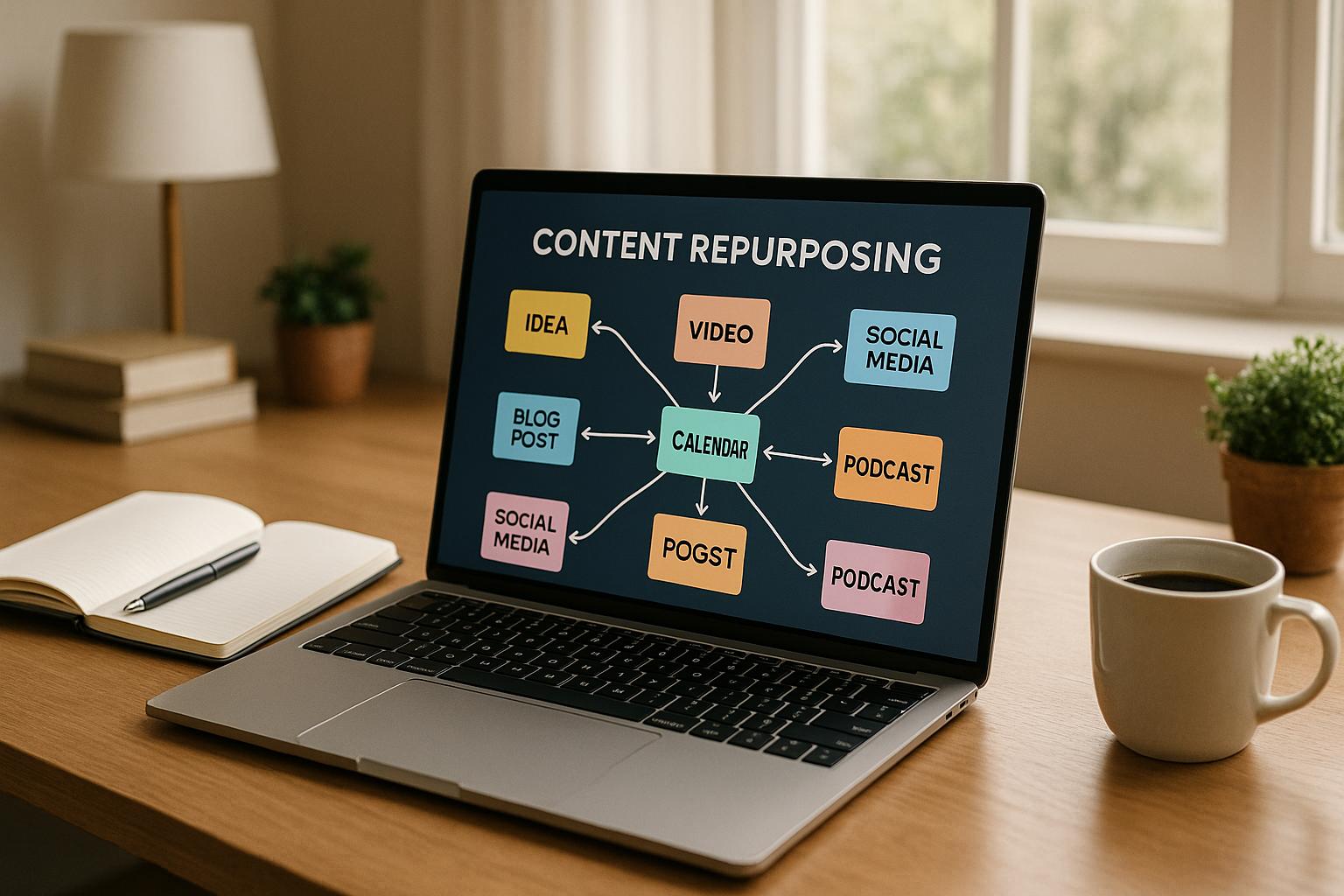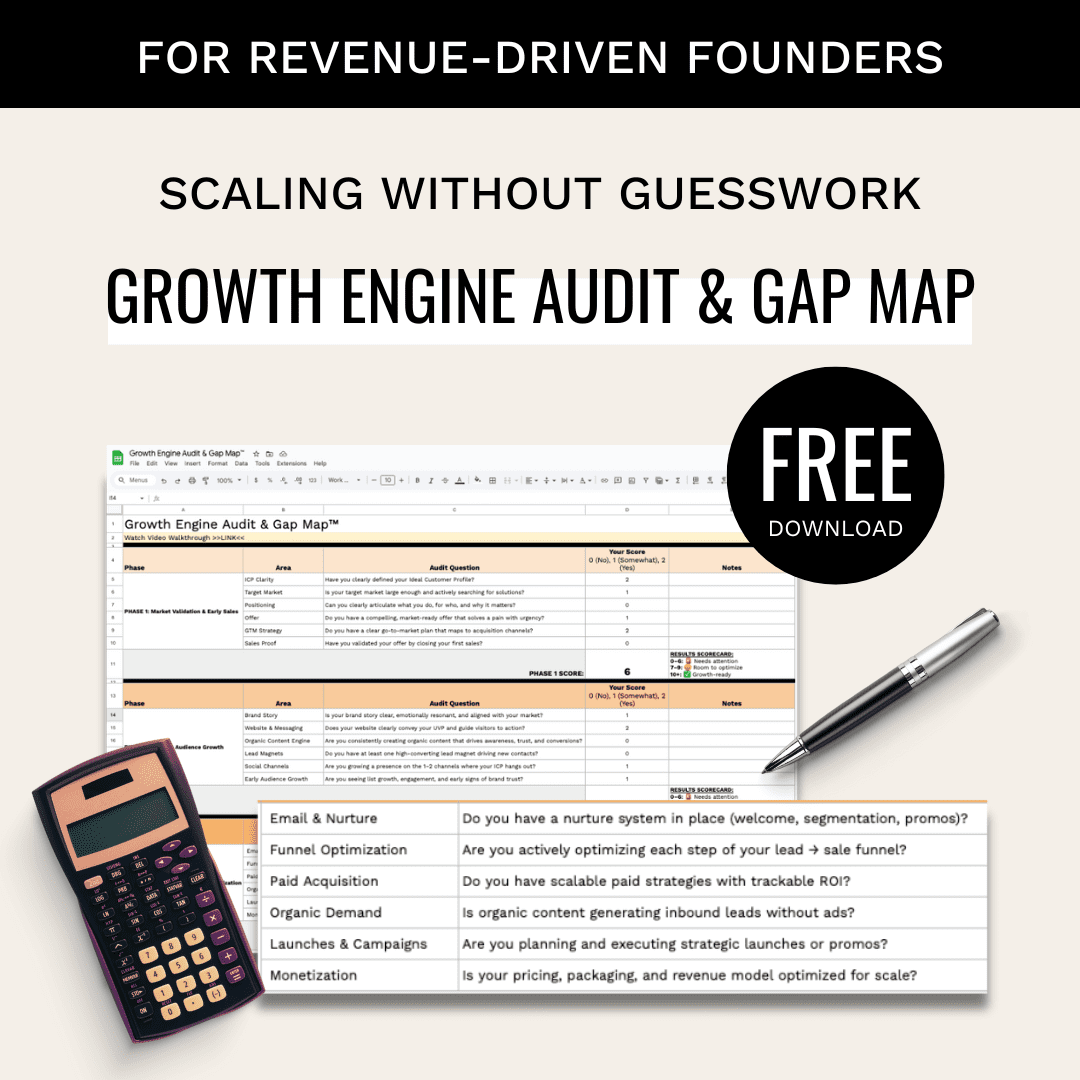Want to save time and get more out of your content? AI content repurposing can help.
Here’s how:
- What It Is: AI tools transform your existing content (like blog posts) into other formats – social media posts, videos, email campaigns, and more.
- Why It Matters: Businesses using AI report a 30% boost in engagement and a 35% increase in leads. Plus, it saves time and reduces costs.
- Key Benefits:
- Automates tedious tasks like reformatting and translation.
- Personalizes content for different platforms and audiences.
- Ensures consistency across all channels.
Ready to get started? This guide covers tools, workflows, and tips to maximize your content’s potential.
How To Repurpose Content with AI [Real Examples] : Copy My Workflow
AI Tools for Content Repurposing
AI tools simplify the process of transforming content into various formats, saving time and enhancing the overall effectiveness of your strategy.
Top AI Content Repurposing Tools
Visual Content Transformation
Canva Pro ($15/month) is a go-to solution for adapting and creating visual content quickly and efficiently.
Video Creation and Editing
Tools like Lumen5 ($19–$149/month), Munch ($49/month), and Vidyo (free plan available, paid plans start at $49/month) make it easy to turn text into engaging video content. FlexClip is another versatile video editing platform offering AI-powered tools like text-to-video, image-to-video, and voiceover features, making content repurposing fast and accessible for everyone.
Text-to-Multiple Format Tools
Unifire ($16–$199/month) and Designrr ($29–$99/month) specialize in converting content into various formats, streamlining the repurposing process.
Platform-Specific Solutions
For LinkedIn, ContentIn‘s AI Ghostwriter refines your strategy, while TRIKL transforms blog posts into videos for multiple platforms. On Twitter, Typefully (free to $79/month) helps craft and schedule threads.
Enterprise-Level Solutions
HubSpot Content Remix starts at $500/month, and AmpiFire offers enterprise-grade services beginning at $2,500/month.
Real-World Success Stories
- Netflix: Their AI tool, "Cinebot", analyzes video content to create trailers and highlight reels tailored to audience preferences.
- BuzzFeed: AI helps break down long-form articles into social media posts and interactive quizzes, each focusing on different aspects of the content.
- Nike: AI tools transform long-form brand stories into short, platform-specific videos and social media snippets, ensuring the message resonates across channels.
These examples showcase the versatility of AI tools in repurposing content effectively. Now, let’s dive into the features that make these tools stand out.
Key Features to Look For in AI Tools
When choosing an AI tool, certain features can significantly enhance its usefulness for repurposing content.
Integration Capabilities
Tools with API access and CMS compatibility can streamline your workflow, saving time and effort.
Multi-Format Support
Choose tools that handle a wide range of content formats. For example, Automata supports over 150 content transformations, offering flexibility for creating diverse outputs from a single source.
Customization Options
A good tool should allow you to tweak tone, style, and complexity to align with your brand’s identity.
Automation Capabilities
Automation is a game-changer. AI can boost productivity by 40%, especially with features like rewriting, summarizing, and format suggestions.
User Interface and Learning Curve
Opt for platforms that are intuitive and easy to use, ensuring your team can adapt quickly. Free trials are a great way to test usability before committing.
Pricing Flexibility
Pricing ranges widely, from basic tools at $10/month to premium solutions. Choose one that fits your budget and scales with your needs.
Analytics and Performance Tracking
Advanced analytics, such as engagement metrics and conversion tracking, help refine your content strategy. For instance, a marketing team cut their content search time by 50% through better categorization and tagging.
Multilingual Capabilities
If you’re targeting global audiences, look for tools that support multiple languages to maintain consistency across regions.
"AI acts as a sidekick, but marketers drive the strategy." – Abstrakt Marketing Group
Transparency is crucial – 71% of users appreciate when AI use is openly disclosed. Striking the right balance between automation and human creativity ensures your repurposed content is impactful and aligned with your goals.
Step-by-Step AI Content Repurposing Workflow
Leveraging AI tools can make content repurposing both efficient and effective. Here’s a structured approach to help you get the most out of your existing content while keeping quality intact.
Audit Your Existing Content
The first step is to identify content that can be repurposed. A thorough audit lets you pinpoint high-potential pieces and understand your current inventory of assets.
Start by gathering all your content URLs using tools like Screaming Frog, then organize them into a spreadsheet. This will give you a clear overview of your digital assets. Focus on evergreen content – content that consistently drives traffic and engagement over time. For example, Backlinko’s "Google’s 200 Ranking Factors: The Complete List", published in 2013, remains successful due to regular updates.
Use analytics platforms like Google Analytics or SEMrush to evaluate performance. Key metrics to track include:
| Metric | Description |
|---|---|
| Social media metrics | Likes, shares, and comments |
| Website engagement | Page views, time on page, and organic traffic |
| Conversion metrics | Conversion rates and lead generation |
| SEO performance | Keyword rankings |
Sort your content into two categories: "rockstars" (top-performing pieces) and "dust collectors" (underperforming ones). Rockstars are ideal for repurposing into various formats, while dust collectors might need updates before reuse.
Keep in mind that 65% of marketers find repurposing content more cost-effective than creating new material, and 46% say updating existing content delivers the best results. To maintain credibility, ensure outdated content is refreshed before repurposing.
Once you’ve identified your strongest pieces, it’s time to let AI work its magic.
Automate Content Transformation
After selecting your top-performing content, AI tools can help reimagine it across different formats while retaining the original message. AI excels at extracting key points and adapting content to suit your chosen format.
Start by outlining specific goals for each piece. Are you turning a blog post into social media snippets? Breaking a webinar into short video clips? Or converting case studies into infographics? Each goal will require tailored AI capabilities.
AI tools don’t just copy content – they adapt and refine it for different platforms. For instance, a LinkedIn post will have a different tone and structure than a TikTok video, even if both originate from the same source. AI can also identify key moments in videos to create short clips, enhance visuals with effects, and even translate content into multiple languages.
A great example is DoorDash, which partnered with Shuttlerock to transform existing video content into reels targeting football fans. This approach boosted their social media engagement.
AI-powered content repurposing saves hours of manual work, allowing teams to focus on strategy. According to Semrush’s 2023 State of Content Marketing report, 42% of marketers have achieved success by updating and repurposing content.
After automation, ensure the final output aligns with your brand standards.
Ensure Quality and Brand Consistency
While AI can speed up the process, human oversight is essential to maintain quality and consistency. AI lacks the creativity and nuance that define a strong brand voice.
Develop clear brand guidelines that outline your tone, visual style, and formatting rules. These guidelines will serve as a framework for reviewing AI-generated content. Studies show that brands with consistent messaging are 3.5 times more likely to achieve strong visibility, and consistent branding can increase revenue by up to 23%.
To improve AI output, train your tools with brand-specific resources like style guides, terminology glossaries, and example materials. This upfront effort ensures consistency across all repurposed content.
Several companies have successfully maintained brand consistency using AI. For instance:
- Microsoft reduced onboarding time by 40% and improved brand consistency scores by 25% using AI-powered co-pilots.
- HubSpot used AI to scan marketing materials for compliance, cutting manual reviews by 50% and speeding up time-to-market by 35%.
- American Express increased email marketing conversion rates by 20% with AI tools that personalized content while preserving their premium tone.
- Unilever utilized AI design assistants to create localized marketing materials across 190 markets, producing brand-compliant assets 60% faster.
Review AI-generated content carefully to ensure it aligns with your standards. Check for broken links, duplicate content, and relevance of visuals. Always edit for accuracy and ensure proper attribution for any sources used.
Create platform-specific AI guidelines that account for the unique requirements of different formats. Establish workflows for human-AI collaboration, such as approval processes or designated AI content reviewers.
"I cannot overstate the importance of content audits. They provide a detailed analysis of existing materials, allowing teams to identify gaps, redundancies, and opportunities for modular, reusable content. By understanding what we have, we can make more informed decisions about how to enhance our content’s effectiveness and ensure it aligns with our goals." – Thomas Murphy, Sr. Customer Success Manager, Kontent.ai
sbb-itb-e8c8399
Measuring AI Content Repurposing Results
Once you’ve set up your AI-powered content repurposing workflow, the next step is to measure its impact. Tracking performance is essential to determine your return on investment (ROI). Interestingly, 94% of marketers already include content repurposing in their strategies.
To get a clear picture of success, focus on metrics that align with your business goals. This means monitoring both engagement statistics and broader business outcomes. By comparing the performance of original and repurposed content, you can fine-tune your approach for even better results.
Key Metrics for Measuring Success
The first step in effective measurement is knowing which metrics matter most for your goals. Instead of tracking everything, prioritize metrics that directly contribute to your objectives.
Start with engagement metrics like click-through rates, views, and social interactions. Pair these with website performance metrics such as traffic, conversions, and bounce rates, using tools like Google Analytics. Search performance is another key area – check how your content ranks for target keywords.
On social media, track interactions such as likes, shares, and follower growth. Jonathan Bland, Co-Founder of Omni Lab, highlights the value of this approach:
"It is crazy! So when you effectively repurpose your content you can: 1. Get your content in front of more people 2. Measure that by measuring how your repurposed content performs".
For podcasts or video content, keep an eye on downloads, average consumption, views, and audience retention. If email marketing is part of your strategy, analyze open rates and sign-up data tied to your email campaigns.
Advanced tracking techniques, like UTM parameters and multi-touch attribution, can offer deeper insights. Focus on metrics that tie directly to business outcomes, such as the number of qualified leads generated from LinkedIn articles.
Financial metrics are equally important. On average, companies see a return of two to three times their initial investment in content marketing. You can also calculate your content utilization rate with this formula:
(Number of repurposed content pieces / Total number of content pieces) x 100.
These metrics establish a foundation for comparing original content with AI-adapted versions.
Comparing Original vs. AI-Adapted Content
Analyzing the performance of original versus AI-repurposed content helps you identify what works best and refine your strategy over time.
Key metrics to compare include reach, engagement (likes, shares, comments), conversion rates, and revenue generated. For website content, evaluate pageviews, time on page, bounce rates, and social shares to determine effectiveness.
Repurposed content often outperforms freshly created material, generating 2–5 times more engagement. This is largely because it’s tailored for specific platforms and audiences. A/B testing can further optimize formats and posting schedules.
| Metric | Original Content | AI-Repurposed Content | Comparison Method |
|---|---|---|---|
| Reach | Platform-specific views | Cross-platform visibility | Track total impressions across formats |
| Engagement | Comments and shares | Total interactions | Sum engagement from all repurposed pieces |
| Conversion Rates | Direct conversions | Conversions from all formats | Compare conversion paths and attribution |
| Revenue | Revenue from the original | Revenue from the campaign | Calculate the total revenue impact |
Beyond these metrics, brand awareness and sentiment analysis offer insights into how audiences perceive your content. By monitoring how different formats affect brand perception, you can determine which approaches resonate most with your audience.
Lead generation is another critical factor. Check download statistics before and after repurposing to see if engagement improves. For video content, review audience retention data to see if viewers are watching until the end.
Some findings might surprise you – like how posts with images get 48% more likes than text-only posts.
Companies that measure ROI are six times more likely to close deals. Regularly reviewing and adjusting your strategy based on data ensures continuous improvement. Start by setting clear goals and translating them into measurable metrics. Then, experiment with formats, platforms, and posting schedules to optimize your strategy.
Finally, establish a baseline before starting your repurposing efforts. This allows you to track progress and calculate the true ROI of your efforts with this formula:
(Value generated by repurposed content – Cost of repurposing) / Cost of repurposing.
Best Practices for AI Content Repurposing
To complement your workflow, these best practices ensure your repurposed content stays ethical and aligns with your brand identity. By setting clear ethical standards and maintaining consistent messaging, you protect your brand’s reputation and build trust. With 65% of organizations now using generative AI regularly, finding the right balance between automation and human involvement is key to maximizing efficiency while avoiding potential pitfalls.
Maintaining Ethical Standards
Being transparent about AI’s role in content creation is crucial. With 71% of people emphasizing the importance of disclosing when AI is involved, honesty about your AI usage strengthens credibility. While you don’t need to flag every instance of AI assistance, significant AI involvement should be acknowledged to maintain trust.
Copyright compliance is another critical factor. Before adapting any material – whether it’s your own or sourced from third parties – ensure you have the proper rights. Formalize reuse and attribution policies to define how content can be legally repurposed across formats and platforms.
AI tools also carry a risk of plagiarism. Studies show that 60% of ChatGPT’s outputs have been flagged for plagiarism. To avoid this, use plagiarism detection tools to check for overlaps with existing content. Additionally, fact-check all AI-generated material, as these tools can sometimes produce unverified or inaccurate information. Chester Avey from GlobalSign explains:
"ChatGPT and other globally recognized tools like Bard, Bing Chat, Claude, Perplexity regularly experience ‘hallucinations’. In simple terms, this is when the language tool dispenses content that is not rooted in factual evidence, but rather, conjecture."
Editors play a vital role in reviewing AI outputs to ensure accuracy and ethical compliance. This step extends the quality control measures outlined in earlier workflows. Given that AI can sometimes generate biased or sensitive content, human oversight is non-negotiable.
When selecting AI tools, prioritize those trained on diverse datasets to encourage inclusivity and fairness. Edit AI outputs to ensure originality and avoid reinforcing biases. Alongside these ethical measures, maintaining a consistent brand message across all platforms is essential for building trust.
Consistency Across Channels
Once ethical practices are in place, focus on delivering a unified brand voice. Train AI tools using specific tone guidelines and examples from your brand to ensure outputs reflect your unique personality rather than generic content.
By 2025, advanced platforms like Optimizely’s AI agents will automatically integrate your brand voice and guidelines into all tasks, simplifying consistency. However, human review remains critical to ensure the AI-generated content aligns with your brand’s values.
AI can help maintain tone across various marketing channels, but quality assurance processes are essential for catching any content that doesn’t align with your brand voice. When adapting content for different markets, AI can adjust the tone to fit cultural nuances, but it’s important to have native speakers or cultural experts review the output.
Regularly update your brand voice guide and retrain AI models to reflect any changes in tone or strategy. Establish clear voice standards and routinely review AI-generated outputs to ensure ongoing consistency.
While AI is a powerful tool, the human touch is irreplaceable in brand storytelling. Use AI to support your storytelling efforts, but let humans shape the key elements of your brand’s origin, mission, and voice pillars. As Abstrakt Marketing Group aptly puts it:
"AI acts as a sidekick, but marketers drive the strategy."
Always review and refine AI-generated content, adding a personal touch to preserve your brand’s unique voice. Think of AI as a helpful assistant, not a replacement for creativity. This approach ensures your brand’s distinct personality shines through in every piece of repurposed content.
As Devin Reed highlights, the quality and clarity of both inputs and outputs are critical – cutting corners is never an option.
Getting Started with AI Content Repurposing
Ready to dive into AI-driven content repurposing? Here’s how to get started. Begin by evaluating your existing content library and identifying opportunities to breathe new life into your top-performing pieces. The goal is to transform these assets into formats that resonate across multiple platforms.
Start by conducting a content audit to pinpoint evergreen topics – those that consistently draw engagement over time. Once you’ve identified these gems, consider which formats – video, infographics, podcasts, or others – would best amplify their reach.
Choosing the right AI tools is critical. Look for platforms that align with your needs in terms of usability, integration, and features. Many tools offer free trials, so take advantage of these to test them out. While some require advanced technical skills, many modern options are designed with user-friendly interfaces, making them accessible for teams of all sizes.
To ensure consistency, establish clear guidelines for AI usage. This includes defining your brand voice and tailoring content to fit the tone of each platform.
Plan strategically with a content calendar. Incorporate repurposing tasks alongside your original content creation efforts. Scheduling these activities ensures you’re maximizing your content’s potential without overwhelming your team. Don’t forget to align your content with the strengths of each platform. For example, what performs well on LinkedIn might need reworking to appeal to TikTok or Instagram audiences. Tailor both format and messaging to suit each platform’s unique vibe.
Quality remains the cornerstone of any successful repurposing strategy. As Devin Reed from Clari puts it:
"I need to know my inputs, my outputs, and it needs to be of the highest quality. We all want to have the best tech. Why should we view our content any differently? We shouldn’t be cutting corners".
Once your workflow is set, start tracking performance from day one. Use analytics tools to monitor engagement, reach, and conversions across platforms. This data will reveal what’s working and where adjustments are needed. Remember, repurposing is a continuous process – experiment, analyze, and refine as you go.
AI can make this process faster and more efficient. Davi Schmidt, Demand Generation Director at SnapLogic, highlights this advantage:
"Content Lab is really modernizing the way we do marketing day to day. It used to take us weeks to find ways to repurpose our event content, and now we can do it in minutes across social, blogs, and videos".
Start small with a few pilot projects, then scale up as you see results. The combination of quality content, strategic planning, and AI-driven efficiency can transform your approach to content marketing.
FAQs
How can I make sure AI-generated content matches my brand’s voice and style?
To make sure AI-generated content aligns with your brand’s voice and style, start by creating clear and detailed brand guidelines. These guidelines should cover your tone, writing style, preferred vocabulary, and any specific rules – what to include and what to avoid. These will act as a foundation for training your AI tools. Include examples of content that truly reflect your brand’s identity to provide a strong reference point.
When using AI to generate content, write precise prompts to steer the AI toward producing material that feels on-brand. Afterward, carefully review and edit the output to ensure it stays consistent, genuine, and aligned with your brand’s messaging. Over time, make regular tweaks and improvements to fine-tune the content and keep it in sync with your evolving voice.
What should I consider when selecting an AI tool for content repurposing?
When picking an AI tool for content repurposing, the first step is to clearly define your goals. Are you looking to expand your audience, increase engagement, or make your workflow more efficient? Having a clear objective will guide you in selecting a tool that fits your specific needs.
It’s also important to assess whether the tool can handle different content formats – like text, video, and audio. Look for one that integrates smoothly with the platforms you already use and offers intuitive features that can help you work faster. Don’t overlook analytics capabilities either; they’re crucial for monitoring performance and refining your approach over time.
Lastly, pay close attention to the output quality. For your repurposed content to resonate and keep your audience engaged, it needs to be polished and impactful. Choose a tool that consistently delivers professional, well-crafted results that align with your standards.
How can I evaluate the success and ROI of my AI-powered content repurposing efforts?
To determine how successful your AI-driven content repurposing efforts are, keep an eye on key performance indicators (KPIs). Pay close attention to engagement metrics like likes, shares, and comments – they reveal how well your content resonates with your audience. Additionally, monitor conversion rates to see if the content is driving the actions you want, such as sign-ups, downloads, or purchases.
When it comes to ROI, the goal is to weigh the revenue generated from your repurposed content against the costs incurred for its creation and distribution. You can use a straightforward formula to calculate ROI: (Revenue - Cost) / Cost × 100%. By tracking these numbers, you’ll not only understand the financial impact of your efforts but also gain insights to fine-tune your strategy for improved results moving forward.
Related Blog Posts
- AI Agents in Marketing: The Secret to Driving 10x Engagement & Conversions
- 5 Ways AI Can Optimize Marketing ROI for your Tech Startup
- AI Growth Marketing: Forecasting Use Cases
- Vibe Marketers: What They Do and Why This Needs to Be Your Next Hire




